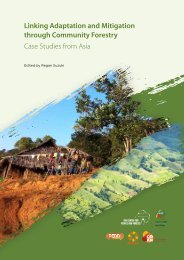Desktop Study on - Regional Climate Change Adaptation ...
Desktop Study on - Regional Climate Change Adaptation ...
Desktop Study on - Regional Climate Change Adaptation ...
You also want an ePaper? Increase the reach of your titles
YUMPU automatically turns print PDFs into web optimized ePapers that Google loves.
<str<strong>on</strong>g>Desktop</str<strong>on</strong>g> <str<strong>on</strong>g>Study</str<strong>on</strong>g><br />
Agriculture and Food Security Sector<br />
Agriculture in Malaysia c<strong>on</strong>tributes to about 10%<br />
of the total GDP and at least a third of the country’s<br />
populati<strong>on</strong> depends <strong>on</strong> the agriculture sector,<br />
with some 14% working in farms and plantati<strong>on</strong>s.<br />
<strong>Change</strong>s in climate will affect the agriculture sector<br />
in term of producti<strong>on</strong> as well as the impacting socioec<strong>on</strong>omic<br />
problems to the people involved in the<br />
sector and the nati<strong>on</strong> as a whole (Kamal, 2007).<br />
From the land use perspective, about 39.2% of total<br />
land use or about 5.18 milli<strong>on</strong> hectares are planted<br />
with tree crops like rubber, oil palm, cocoa, coc<strong>on</strong>ut,<br />
fruits and vegetables.<br />
Range of Studies Reviewed and<br />
Methods Applied<br />
No methods were found in the studies reviewed,<br />
the studies include, Siwar et al., Kamal (2007),<br />
Ramadasan et al. (2001), Ziska et al. (1997), Al-Amin<br />
and Chamhur (2008), etc., which all c<strong>on</strong>sider and<br />
review the impacts of climate change <strong>on</strong> Malaysian<br />
agriculture, as a key ec<strong>on</strong>omic sector, and establishing<br />
linkages with sustainability and poverty.<br />
Impacts <strong>on</strong> the Agricultural and Food<br />
Sector<br />
Agriculture is <strong>on</strong>e of the sectors that is greatly affected<br />
by extreme climate change and it is proved that it has<br />
an important role <strong>on</strong> crop development. The climatic<br />
factors like the amount of rainfall, sunshine hours,<br />
temperature, etc. result in year-to-year variability<br />
of crop producti<strong>on</strong>, as well as physical damage,<br />
lost of crop harvest, drop in productivity, vigour<br />
and others. Also high temperatures and reducti<strong>on</strong><br />
of rainfall induce loss of soil moisture, reducing<br />
the water available for irrigati<strong>on</strong> and damaging<br />
crop growth in n<strong>on</strong>-irrigated regi<strong>on</strong>s (Siwar et al.,<br />
2009). <strong>Climate</strong> change is <strong>on</strong>e of the major potential<br />
threats to nati<strong>on</strong>al food security and agriculture for a<br />
country. As the change of climate is a c<strong>on</strong>tinuous and<br />
l<strong>on</strong>g-term process, its impacts will c<strong>on</strong>tinue for l<strong>on</strong>g<br />
successive years.<br />
Changing climate affects the agriculture industry; for<br />
example, increasing rainfall is not good for rubber,<br />
which will also suffer due to lost of tapping days and<br />
crop washouts. However, some other crops like oil<br />
palm could flourish with higher rainfall, c<strong>on</strong>sidering<br />
that excessive rainfall is detrimental but may be<br />
negatively affected in temperature raise scenario<br />
that causes drought (Ramadasan et al., 2001). It was<br />
reported that flood related problems in southern<br />
Malaysia had decreased the producti<strong>on</strong> of crude palm<br />
oil to 1.1 milli<strong>on</strong> metric t<strong>on</strong> or 26.3% in December<br />
2006 (Kamal, 2007).<br />
The impact of climate change <strong>on</strong> agriculture (rice)<br />
producti<strong>on</strong> has been a subject to many scientific<br />
researches due to its important <strong>on</strong> human being. The<br />
actual farm yields in Malaysia vary from 3-5 t<strong>on</strong>s/ha.<br />
The rice crop, in general resp<strong>on</strong>ds positively to an<br />
increase in atmospheric CO2 c<strong>on</strong>centrati<strong>on</strong>; there is<br />
an increase in rates of rice crop in CO2 c<strong>on</strong>centrati<strong>on</strong><br />
from 160 ppm to 900 ppm. However the yield<br />
resp<strong>on</strong>se to CO2 varies with cultivars, locati<strong>on</strong> and<br />
management practice and also the negative effects<br />
occur in unexpected high or low temperature (Siwar<br />
et al., 2009). Generally, the effect of increasing<br />
temperature above the tolerance limit <strong>on</strong> rice<br />
producti<strong>on</strong> is negative because the photosynthesis<br />
is reduced, the respirati<strong>on</strong> is increased and the<br />
vegetati<strong>on</strong> and grain-filling periods are shortened.<br />
The average temperature in rice-growing areas<br />
in Malaysia is about 26°C. An examinati<strong>on</strong> of the<br />
current climate change scenario under different<br />
future climate change indicates that temperature<br />
above 25°C may decline grain mass of 4.4 % per 1°C<br />
rise and grain yield may decline as much as 9.6 to<br />
10%. Similar results were found by Ziska et al. (1997)<br />
and they menti<strong>on</strong>ed those flowering and grain-filling<br />
periods were affected by an increase in temperature<br />
above the present ambient level. It was found <strong>on</strong> rice<br />
producti<strong>on</strong> in Malaysia that rice yield declines from<br />
4.6% to 6.1% per 1°C under the present CO2 level.<br />
Greater yield reducti<strong>on</strong> is envisaged with increasing<br />
temperature at higher level. However, a doubling<br />
of CO2 c<strong>on</strong>centrati<strong>on</strong> (from present level 340 to<br />
680ppm) may offset the detrimental effect of 4°C<br />
rise in temperature (Al-Amin and Chamhur, 2008).<br />
The sustainability of food supply can also be affected<br />
by climate change because of variati<strong>on</strong>s in yields due<br />
to changes in rain and temperature that also could<br />
fasten the spread of fungus, insects and diseases due<br />
to the fact that the range of insects will expand or<br />
change, and new combinati<strong>on</strong>s of pests and diseases<br />
may emerge as natural ecosystems resp<strong>on</strong>d to<br />
shifts in temperature and precipitati<strong>on</strong> profiles;<br />
thus affecting yield. States that are most vulnerable<br />
to these changes are in the northern Peninsular<br />
Malaysian regi<strong>on</strong> as well as the coastal regi<strong>on</strong>s<br />
of Sabah and Sarawak (Kamal, 2007). The effect<br />
of climate <strong>on</strong> pests may add to the effect of other<br />
factors such as the overuse of pesticides and the loss<br />
of biodiversity which already c<strong>on</strong>tribute to plant<br />
pest and disease outbreaks (Al-Amin and Chamhur,<br />
2008).<br />
With regards to irrigati<strong>on</strong> supply for agriculture and<br />
food producti<strong>on</strong>, water shortages are also experienced<br />
in varying degree of severity, and in the past, prol<strong>on</strong>g<br />
146

















